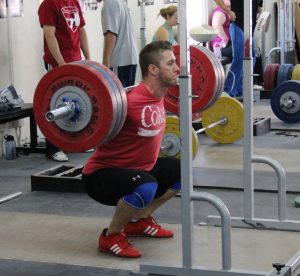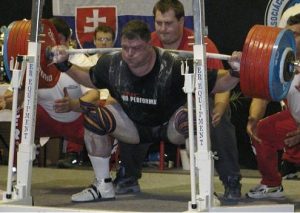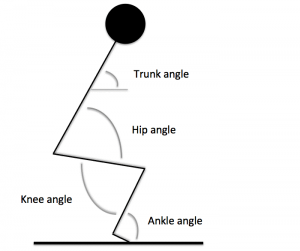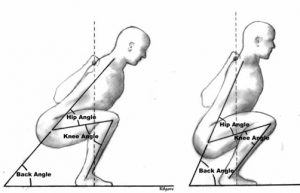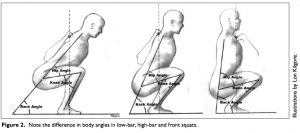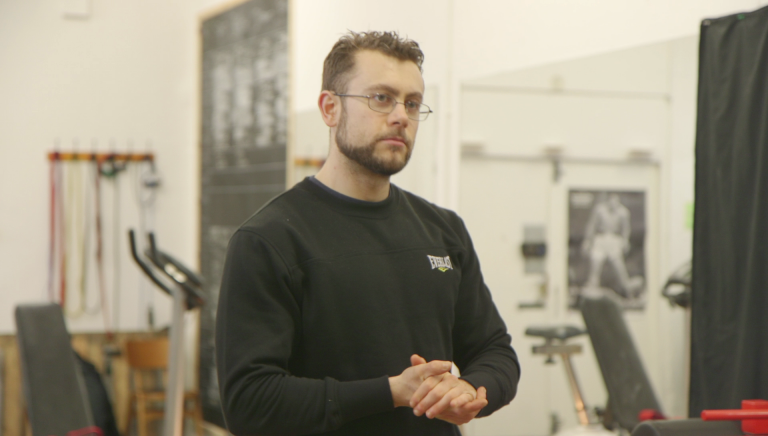The Squat; A Bio-Mechanical Assessment
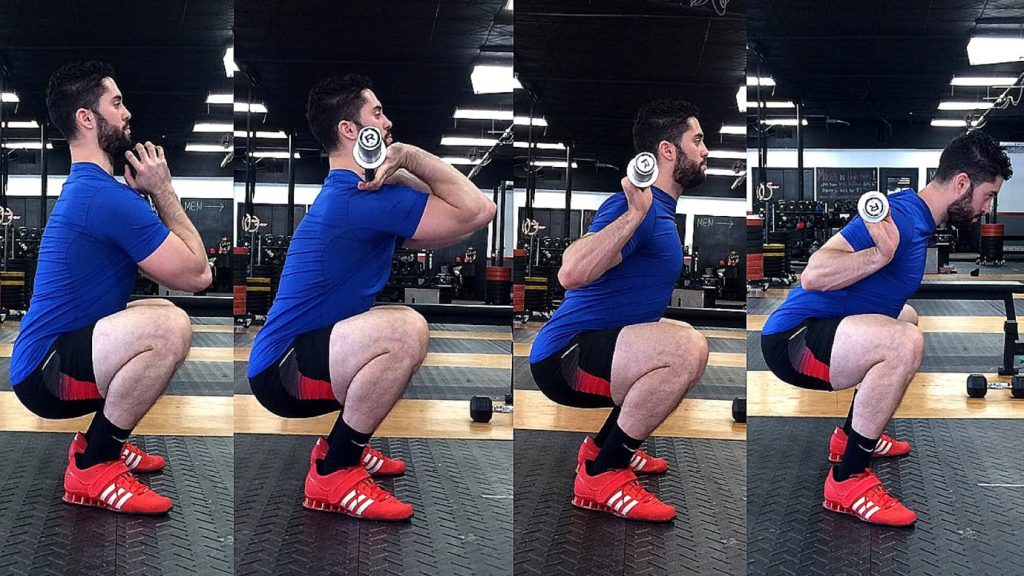
Introduction
We all know how to squat, right? Our coaches make sure that our techniques are correct, and make sure that we’re making the most of our bio-mechanical advantages. Whether we squat to increase the weight we can move, or as an assistance exercise for other movements, there are reasons why the movements are different.
This article will help explain the difference, mainly, between the ‘powerlifting’ squat and the ‘weightlifting’ squat, and also some of it’s variations. For the majority of research conducted, and the results and conclusions presented here, the ‘powerlifting squat’ is more often than not equipped (suit/wraps) – although a lot of the basic structure of movement can also be related to raw lifting.
A Little Background
First, Olympic lifters don’t compete in the squat. They use it as an assistance exercise to aid in their competition lifts: the snatch and the clean & jerk.
Second, for the most part, Olympic squats and powerlifting squats are completely different animals from the ground up. We’ll start with the Olympic squat.
In 2012 a study was conducted, who’s purpose was to compare the biomechanics of the traditional (Olympic style) squat with 2 popular exercise variations commonly referred to as the powerlifting squat and box squat. Twelve male powerlifters performed the exercises with 30, 50, and 70% of their measured 1 repetition maximum (1RM), with instruction to lift the loads as fast as possible.
During the eccentric phase of the traditional squat, the knee travelled past the toes resulting in anterior displacement of the system centre of mass (COM). In contrast, during the powerlifting squat and box squat, a more vertical shin position was maintained, resulting in posterior displacements of the system COM. These differences in linear displacements had a significant effect (p < 0.05) on a number of peak joint moments, with the greatest effects measured at the spine and ankle. For both joints, the largest peak moment was produced during the traditional squat, followed by the powerlifting squat, then box squat. Significant differences (p < 0.05) were also noted at the hip joint where the largest moment in all 3 planes were produced during the powerlifting squat. Coaches and athletes should be aware of the biomechanical differences between the squatting variations and select according to the kinematic and kinetic profile that best match the training goals.
The Olympic Squat
The Olympic squat (or back squat as it’s known in Olympic lifting circles), is categorized as a high bar squat. The bar is placed on top of the traps, on the shelf created by retracting the shoulder blades between the upper trapezius and the middle trapezius. The torso is relatively upright during both the descent and the ascent of the lift.
The feet are positioned somewhere between straight ahead and externally rotated approximately 15 degrees and set approximately shoulder-width apart. The hands are placed in the same position as in the clean; in the case of the heavyweights and superheavies, sometimes slightly wider.
Unlike the powerlifting squat, Olympic lifters stay relatively relaxed under the bar, preferring a “long spine” position where they lengthen from the crown of the head to the coccyx. They use high-tension techniques sparingly. These squats are performed relatively fast with a quick, yet controlled eccentric and an explosive concentric action.
This matches the sporting need of the lifter to pull himself under the bar and recover the lift quickly. Too much tension will slow him down and cause him to miss the lift.
The Olympic squat – note the high bar position, upright torso, full depth and knees over toes
The high-bar squat is primarily an assistance exercise utilised by Olympic weightlifters for strength development. High tension, max effort lifts are used sparingly with squats generally performed without any sort of emotional arousal or supportive gear (belts, wraps, etc.). Olympic lifters will squat 3-5 times a week in most instances; more frequently than powerlifters. Here’s an example of an Olympic style squat by Lu Xiaojun, who at 77kg bodyweight has squatted 300kg previously:
Key Execution Points:
- Stance is shoulder width with toes either straight ahead or slightly pointed out. The narrower stance places greater emphasis on the quads during the lift and also requires greater flexibility of the foot and ankle complex.
- The bar is sat high-bar – positioned high on top of the traps and in the ‘shelf’ created by pulling the shoulder blades down and together. This helps maintain an upright torso which is necessary for a full deep squat.
- Grip is clean width, which is relatively narrow, and elbows are orientated directly under the bar keeping the forearms perpendicular to the floor. These points also help reinforce the vertical torso.
- Strict Olympic squats are initiated at the knee, not at the hip, again helping to maintain a vertical torso. The torso remains as vertical as possible during the entire performance of the lift.
- Lifts are performed to full knee flexion with hamstrings covering calves with knees generally travelling over the toes. As inadequate flexibility of the foot and ankle complex can often restrict individuals from getting into this deep position, Olympic squatters will often wear weightlifting shoes which have a raised heel.
- Lifts are performed with a quick, although still controlled, eccentric phase and an explosive concentric phase.
Benefits:
- Strengthens through a greater range of motion
- Less stress on lower back
- Forces are balanced relatively equally between the hip and knee extensors
Drawbacks:
- Less weight can be lifted
- Reinforces quad dominant movement patterning
- May be contraindicated for those with acute knee problems
The Powerlifting Squat
In the rules that govern the sport of powerlifting in accordance with the International Powerlifting Federation, “the lifter must bend the knees and lower the body until the top surface of the legs at the hip joint is lower than the top of the knees.” The idea is to descend low enough for the hip crease to be beneath the top of the thigh and then return to the starting position.
The powerlifting squat is about lifting more weight, not necessarily getting stronger. This may be a controversial statement, but most powerlifters will tell you that they don’t care if you’ve gotten stronger or not; they simply want to know how much you lifted in any given meet.
There used to be two main schools in powerlifting: “Assistive Gear” and “More Assistive Gear” (equipped), although now raw federations and meets are making a big comeback. The two major international federations in both ‘equipped’ and ‘raw’ lifting are the IPF and the WPO.
Broadly speaking, the IPF was dominated by the Eastern Europeans who used a hybrid type squat, which we’ll discuss shortly. The WPO is a multi-ply federation, and their lifters use a squat style designed to optimize the advantages of their extra assistive gear. Let’s discuss the WPO style of squat first because it best contrasts the idea of “lifting more” as opposed to getting stronger (although these lifters are obviously still very strong).
This style of squat is characterized by a low bar placement across the rear deltoids with the shoulder blades retracted and with a very wide foot placement. It’s initiated with the hips; the shins stay perpendicular to the floor during the entire lift. This reduces the reliance on the quadriceps and maximizes the contribution of the hamstrings, gluteals, lower back, and the assistive gear.
There’s a forward torso displacement during the descent and ascent. The hands, although in theory are kept close to the torso, are usually placed almost collar-to-collar among the heavyweights and supers due to lack of shoulder flexibility from bench press specialisation and torso girth. Because of the massive loads used in the upper weight categories and the bar positioning, high-tension techniques are practiced routinely on this style squat.
The powerlifting squat – note the low bar position, forward lean and depth just below parallel.
Unlike Olympic lifters, powerlifters compete in the squat. For that reason, the emphasis with the powerlifting squat isn’t so much on strength development as it is on lifting as much weight as possible. That’s not to say it’s inferior to the Olympic squat for developing strength, it just maximises biomechanical advantages in order to lift more weight. Powerlifters squat less frequently than Olympic lifters as they tend to use high load, high tension efforts more often; the massively popular Westside training template calls for one max effort day with heavy weights and one dynamic day with a lighter weight a week. Because the high load techniques used are so demanding on the central nervous system, some powerlifters have been known to train exclusively with box squats – a variation slightly less taxing neurally. Who better to demonstrate a powerlifting style squat than Andrey Malanichev, one of the greatest powerlifting squatters of all time, here squatting 440kg for 3 reps ‘raw with wraps’:
Key Execution Points:
- Stance is wide, generally up to double that of shoulder width, and feet are externally rotated. A wider squat emphasises the adductor group (particularly adductor longus) and the external rotation emphasises glute activation.
- Barbell is sat ‘low bar’ – positioned across the rear delts and the spine of the scapula. Wearing the bar lower on the back has the biomechanical advantage of moving the centre of mass closer to the joints and decreasing the moment arm.
- As the low-bar position also moves the load backward slightly, toward the heels, this forces the torso to lean forward slightly to maintain balance. The lean serves to increase loading in the lower back, glutes and hamstrings.
- Grip is often wider than with the Olympic squat, often dictated by shoulder flexibility of the lifter, and elbows are orientated behind the bar. These points again reinforce a slight forward lean.
- The squat is initiated by hinging at the hips and sitting back. Lifters attempt to keep shin angle as vertical as possible.
- Lifters descend until the hip joint is parallel (just below) to the knee joint.
Benefits:
- Maximises leverages and ultimate weight lifted
- Increases loading in the posterior chain
- Reduces stresses on the knee joint
Drawbacks:
- More stress on the lower back
- Reduced range of motion
The Hybrid
In reality, few people are strict Olympic or powerlifting squatters. When you consider the nine variables we’ve mentioned (stance width, foot rotation, bar position, grip width, elbow orientation, torso position, amount of hip flexion, depth, speed of movement) it’s clear that there are almost countless permutations and it’s highly unlikely that two people will squat identically. In the majority of instances, with both general and athletic populations, the squat is coached as somewhat of a hybrid between the two, particularly when remembering that the main bio-mechanical position mentioned above is for lifters wearing supportive gear, which changes the movement. This hybrid technique generally fuses the upper body portion of the Olympic squat with the lower body portion of the powerlifting squat. This means the high(er) bar position and upright torso of the Olympic squat combined with the hip hinge and depth just below parallel of the powerlifting squat. The rationale is that the hybrid is a compromise between the low back and knee sparing techniques of the respective lifts.
Comparing high bar and low bar squats
High Bar Squat (Olympic Squat)
High bar squatting has been popularized by the sport of weightlifting. In a high bar Olympic lifting style squat, the bar is placed high on the trapezius muscles (traps) and on the cervical vertebra of the spine. The initial break of the movement occurs at the knee as the hips descend low with as little hip extension as possible, resulting in larger amounts of knee flexion and ankle dorsi-flexion. The spine is loaded starting high thoracic and/or low cervical.
During the eccentric phase, the knees travel towards the toes resulting in anterior displacement of the centre of mass (COM), keeping the bar over the mid foot. The purpose of this style of squat is the carry over into the two disciplines of Olympic weightlifting: the snatch and the clean & jerk. In the high bar squat, athletes traditionally squat two to three inches below parallel. When the stretch shortening cycle occurs here, it also dissipates sooner – just out of the hole. If the lifter is able to maintain a vertical bar path, the limiting factor to finish the lift is simply the strength of the thoracic erector. On average, Olympic lifters train this component more than powerlifters, with the variation of pulls being performed in training.
A diagram showing the body position in a high and low bar squat respectively
Low Bar Squat (Powerlifting Squat)
The low bar squat is predominantly used in powerlifting training programs and has the bar placement down on the low cervical vertebra, high thoracic vertebra and across the contracted posterior deltoids. In contrast to the high bar squat, keeping the bar over the mid foot and maintaining a strong COM requires greater hip extension to maintain balance. This places a different load on the spine and produces less shearing than the traditional high bar squat.
A similar study to that mentioned at the top of this article (in regards to population number/gender/ability and percentage of 1RM evaluated) was published in the Journal of Strength and Conditioning Research, a cross sectional repeated measures design was used to compare the kinematics and kinetics of the traditional high bar squat with the low bar squat. The experimental approach tested twelve male powerlifters performing various styles of squatting using loads of 30, 50 and 70 percent of their recorded one rep maxes.
In this study, researchers used “markers placed on the spinous process of the seventh and third thoracic vertebra, suprasternal notch, inferior tip of the xiphoid process, left and right anterior superior iliac spine, left and right lateral femoral epicondyle, left and right malleolus, and left and right heads of the second metatarsal.” Using a nine camera motion analysis system, researchers were able to identify large anterior displacement on the knee.
Surprisingly, the greatest amount of peak joint torque at the lumbar and sacrum (L5/S1) was not from the powerlifting squat style, but from the traditional Olympic squat style. To be fair, we are not comparing apples to apples here.
First, the lifters only reached 70 percent of their one repetition maximum. If you’re an active lifter, you know 30 percent, 50 percent and sometimes even 70 percent can create different neurological demands on the body when compared to 95 or 100 percent. Second, while these are simply variations, the data from this study does reveal something worthy of consideration.
Hamstrings and high bar squatting
The high bar squat promotes a larger moment arm anteriorly due to the positioning of the bar, resulting in anterior displacement of the COM. The hamstrings are not being lengthened to the same degree, thus not generating as much eccentric load. With a more eccentric load, the hamstrings can effectively contract as they reach the limit of elasticity. This concept is known by exercise physiologists as the stretch-shortening cycle (SCC). Elastic energy in the musculotendinous components is increased with a rapid stretch, and then stored. After an SCC occurs, a rapid concentric contraction allows the stored energy to be released, maximizing total force production. However, if the concentric contraction does not happen fast enough, elastic energy is released as heat.
Using a low bar position in the squat utilizes the posterior chain more than the anterior. When the hips go into extension, the stance sometimes becomes wider to allow for greater extension and more efficient use of the posterior chain. This hip position will primarily load the gluteus, hamstrings, hip abductors and adductors while still involving the anterior chain with the quadriceps being eccentrically loaded during the decent. The low bar squat typically results in maximum muscle involvement, as posterior muscles are recruited more effectively than the high bar squat. Maximal muscle involvement means more muscle fibres are involved with an eccentric load, more stretch shortening cycles (SSC) occur, and firing of more contractile units fire, creating a higher force production.
Squatting below parallel
The Olympic style squat places a greater emphasis in owning a lower portion of the squat at two to three inches below parallel, while the powerlifting squat will break parallel just enough to satisfy the rules of the sport. The stretch shortening cycle occurs from the bottom of the squat into the first two to three inches of the ascent.
Studies have shown the difficulty for most powerlifters occurs above parallel. The stretch shortening cycle happens just below 90 degrees, and creates speed going into the sticking point sooner than a deep high bar squat. A deep high bar would have more speed coming from a much lower position going into parallel rather than just above it. This is one of the theories as to why, on average, heavier squats worldwide are performed using the low bar squat.
The equipped IPF lifters use modified styles of the Olympic and WPO lifters: low bar placement, medium hand spacing, and a just-wider-than-shoulder-width foot position. Their assistive gear provides less support/enhancement (single-ply) when compared to the WPO/WPC. Some have argued that the wide stance squat of the WPO/WPC lifters has evolved to maximize the limits of the gear, and I’d tend to agree.
The barbell squat is a key exercise in strength and conditioning programs. There are many barbell squat variations, which can be classified in different ways (including barbell placement, technique, stance width or foot placement, and fixed or free weight).
Based on changes in muscle activity with load, bar speed, and ROM, the prime movers in the back squat include the quadriceps, gluteus maximus and erector spinae. The hamstrings appear to function as antagonist co-contractors. The roles of the adductors, gastrocnemius and soleus and abdominals are unclear, apart from stabilising.
During the back squat, using a wider stance and knee wraps has been seen to increase gluteus maximus muscle activity, while using running shoes rather than no footwear increases quadriceps muscle activity.
Most squat variations appear to lead to similar quadriceps, gluteus maximus and erector spinae muscle activity, but the back squat (high bar) seems to display greater quadriceps muscle activity than either the split squat or overhead squat.
No other exercise has been found to involve greater quadriceps muscle activity than the back squat (high bar) but the barbell hip thrust involves greater gluteus maximus activity and the deadlift involves greater erector spinae muscle activity.
Heavier loads are lifted during partial rather than parallel squats, by individuals with greater levels of resistance-training experience, and by athletes using a powerlifting-style of squat compared to an Olympic weightlifting-style of squat. Ground reaction forces appear to be primarily a function of the absolute loads used.
The optimal load for power during back squats is unclear. Supportive equipment (knee wraps, suits and belts) appear to increase power output, most likely by increasing velocity as a result of stored elastic energy and increased inter-abdominal pressure, relatively, in the lowering phase. Greater rate of force development seems to be observed in the box squat than in other squat variations.
Greater trunk angles in the back squat are observed in subjects wearing no footwear rather than running shoes and when using cues to restrict the movement of the knees over the toes. The effect of cues to prevent knee movement over the toes on peak hip angle is unclear but cues to look downwards rather than upwards lead to more acute hip angles, while increasing fatigue leads to less acute peak hip angles.
Increasing load and wearing running shoes rather than no footwear appear to lead to more acute peak knee angles, while using cues to prevent forward knee movement over the toes and fatigue lead to less acute knee angles.
Using weightlifting shoes and running shoes both lead to more acute peak ankle angles than using no footwear, while cues to prevent the knee from moving forward over the toes lead to less acute peak ankle angles.
Hip extensor moments in the back squat (high bar) increase with increasing relative load, squat depth, trunk lean and with cues to prevent forward movement of the knees over the toes. They are greater using a powerlifting-style squat than a traditional squat. When using Smith machine squats, hip extensor moments are greater with a foot position that is further forward of the barbell or a backward body inclination.
In contrast, knee extensor moments in the back squat (high bar) increase with increasing relative load and squat depth but reduce with cues to prevent forward movement of the knees over the toes or with greater trunk lean. They are greater using a traditional squat than when using a powerlifting-style squat but similar during back and front squats.
When using Smith machine squats, knee extensor moments are greater with a foot position that is closer toward the barbell or a forward body inclination.
The test-re-test reliability of back squat 1RM testing is generally nearly perfect or very high, although a familiarization effect has been observed over subsequent sessions. In trained individuals, a difference of 4% can differentiate between individuals, and a difference of 8% can establish a real training effect. In untrained individuals, much larger differences may be necessary.
Before we go further, I’ll clarify what is meant by ‘moment(s)/moment arms’;
Moment(s) / Moment Arms
Moments are also known as “moments of force”, “turning forces” or torque. They can be thought of as forces applied in a rotational system, horizontally & vertically. Moments are vectors and therefore have both a direction and a magnitude.
The magnitude of a moment is dependent not only upon the size of the perpendicular force exerted but also upon its distance from the pivot, which is called the moment arm length.
Practical Perspective
Net joint moments are produced by the balance of agonist and antagonist muscle forces, and their associated internal moment arm lengths. They are exerted in order to overcome an external load and its associated external moment arm length, which produces a requirement for an internal net joint moment. Many exercises have a particular point in the range of motion that is harder than the rest of the movement. In most cases, this is caused by differences in external moment arm lengths. However, changes in internal moment arm lengths can also lead to differences in the necessary muscle force at different joint angles. Understanding how both external and internal moment arm lengths change during an exercise is therefore helpful for appreciating its effects on the requirement for muscle force at a specific joint angle.
Joint moments that we measure are the net effect of the positive agonist muscle forces and associated moment arm lengths and the negative antagonist muscle forces and their associated moment arm lengths. They are therefore more properly called net joint moments.
The following diagram shows a representation of the squat in the bottom position performed with a medium width stance by masters powerlifters, with the joint angle data taken from Escamilla et al. (2001a) and the segment length data taken from Zatsiorsky et al. as reported in De Leva (1996).
Effect of Equipment
Exploring the effects of supportive gear, Zink et al. (2001) found no effect on peak trunk angle of using a weightlifting belt. Sinclair et al. (2014) compared the use of weightlifting shoes, minimalist footwear, running shoes, and no footwear (barefoot) and found no differences between conditions. However, Sato et al. (2013) found that no footwear allowed greater trunk lean than wearing running shoes.
Effect of Exercise Cues
Taking the trunk as a single segment, Donnelly et al. (2006) found that peak trunk angle was similar whether lifters were cued to look downwards or upwards; both Fry et al. (2003) and Hirata and Duarte (2007) found that when artificially restricting forward knee motion, this produced greater forward lean and hence a more acute peak trunk angle. Taking the trunk as multiple segments, List et al. (2013) found that peak thoracic trunk angle was greater when artificially restricting forward knee motion using visual cues compared to unrestricted squats, and peak lumbar trunk angle displayed a non-significant trend in the same direction.
Effect of Hip Joint Angles
Comparing the effects of squats with different stance widths, Escamilla et al. (2001) compared narrow, medium and wide stance back squats and found that peak trunk angles did not differ between variations.
Effect of Exercise Variation
Both Russell and Phillips (1989) and Diggin et al. (2011) reported that peak trunk angle was more acute during the back squat than during the front squat (performed to a standardized depth). McCurdy et al. (2010) reported that peak trunk angle was more acute during the back squat than during a rear-foot elevated split squat. Swinton et al. (2012) found that peak trunk angle was similar in the traditional and powerlifting squat variations but was much less acute during the box squat. Lander et al. (1986) found no difference in trunk angles between back squats and squats using a cambered bar. Finally, Gutierrez and Bahamonde (2009) found that peak trunk angle was more acute during a free weight back squat compared to a Smith machine squat.
External Moment Arm Lengths: Spine
Effect of Exercise Variation
Comparing different squat variations, Swinton et al. (2012) reported that peak lumbosacral moment arm lengths were greater in the traditional and powerlifting squat variations than in the box squat variations. However, there was no difference between the traditional and powerlifting squat variations.
External Moment Arm Lengths: Hip
Effect of Hip Joint Angle
Comparing the effect of squats with different stance widths, Escamilla et al. (2001a) reported no differences in hip moment arm lengths between the narrow, medium, and wide stance width squats at any point in the lowering and lifting phases, except at 45 degrees of knee flexion in the lifting phase, when the medium and wide stance width squats displayed greater hip moment arm lengths than narrow stance width squats.
Effect of Exercise Variation
Comparing different squat variations, Swinton et al. (2012) reported that peak hip extension moment arm lengths were greater in the traditional and powerlifting squat variations than in the box squat variations. However, there was no difference between the traditional and powerlifting squat variations.
External Moment Arm Lengths: Knee
Effect of Hip Joint Angle
Comparing the effect of squats with different stance widths, Escamilla et al. (2001) reported no differences in knee moment arm lengths between the narrow, medium, and wide stance width squats at any point in the lowering and lifting phases, except at 45 degrees of knee flexion in both lowering and lifting phases, when the wide stance width squats displayed greater knee moment arm lengths than either medium or narrow stance width squats.
Effect of Exercise Variation
Comparing different squat variations, Swinton et al. (2012) reported that peak knee extension moment arm lengths were greatest in the order box > traditional > powerlifting squat variations.
External Moment Arm Lengths: Ankle
Effect of Hip Joint Angle
Comparing the effect of squats with different stance widths, Escamilla et al. (2001a) reported differences in ankle moment arm lengths between narrow, medium, and wide stance width squats at most points in the lowering and lifting phases. In general, wide stance width squats displayed large, negative ankle moment arm lengths, medium stance width squats displayed small, negative ankle moment arm lengths, and narrow stance width squats displayed small, positive ankle moment arm lengths.
Effect of Exercise Variation
Comparing different squat variations, Swinton et al. (2012) reported that peak ankle moment arm lengths were greater in the traditional squat variation than in either the powerlifting or box squat variations. However, there was no difference between the powerlifting and box squat variations, and only positive ankle moment arm lengths were observed for all types of squat.
Maximising Muscle Recruitment
To maximize any movement of power, two things must be considered: the amount of muscle tissue involved and the total force produced. Every time a muscle is lengthened, it is the antagonist of a prime mover. This is known as an eccentric load.
When a muscle is loaded eccentrically, it can store energy and have a higher stretch reflex. Therefore, a squat recruiting more muscles to load eccentrically will result in a better stretch reflex resulting in a higher rate of force development.
When squatting with a high bar, the initial break is not usually at the hips but rather at the knees and ankle. This causes your lower body to go into knee flexion and ankle dorsi-flexion. This position primarily loads the quadriceps and gastrocnemius muscles eccentrically, and provides a strong stretch reflex within the quadriceps as they are being lengthened.
Maximal amounts of knee extensor torque take place in the bottom position of the squat, thus taxing the quadriceps. EMG studies show maximal quadriceps activation is +80 degrees of knee flexion while maximum glute activation is found at +90 degrees of knee flexion, as in the powerlifting squat.
Bar and foot placement
Your bar placement can directly affect your foot placement. A low bar squat forces you to externally rotate your feet, tibias, and femurs to allow a wider and stronger base of support. For most low bar squatters, approximately 30 degrees is common.
As soon as your femurs go into slight external rotation, the hip abductors, TFL (small muscle that connects the hip at the anterior iliac crest to the lower leg), the gluteus medius and gluteus minimus all work together to abduct the distal end of the femur. During the descent of the squat, when feet are generally externally rotated around 30 degrees, the hip extensors begin to shorten through concentric contraction. The adductors, and primarily the adductor magnus, begin to load eccentrically as you descend. Lowering the bar forces the hips into hip greater flexion while maintaining a contracted erector spinae, thus leading to a greater load of the hamstrings.
Minimising Lever Arm Length
Maximizing your lift by minimizing your lever length will produce a greater strength benefit. Results of a study published in the Medicine and Science in Sports and Exercise Journal, determined that;
“low-bar squatting techniques involve greater hip flexion and thus greater hip moments of force, while in the high-bar technique, the load is more equally distributed. The greater amount of hip flexion allows the lifter to balance the bar closer to the knee, reducing the moment arm between the knee and the weight. This reduces knee moment forces and the patello-femoral compression force. This also results in greater reliance in the hip and back musculature, allowing the individual to lift more weight, which is crucial to powerlifters.”
A two to three degree hip flexion is the average difference compared to the high bar squat, simply to keep the COM in balance as the athlete places the bar lower on the rear delts. While not vastly significant, it changes the squat slightly. Because of this change in bar and torso position, the amount of thoracic moment is reduced, placing the hips slightly back creating more hip and erector moment and thus requiring more hip torque to overcome the load.
To conclude, it is evident that there are many variables in the squat, and there is no ‘one size fits all’ set of instructions. A good coach will know the parameters, and what works best (in general) for your desired sport and goals. It is important that you have your squat assessed by a qualified, experienced coach to ensure that you’re not only making the most of your potential and bio-mechanical advantages, but also to prevent injuries.
An interesting (and quite long video) is Ed Coan and Mark Bell discussing and demonstrating the squat:
References
https://www.ncbi.nlm.nih.gov/pubmed/22505136
https://www.t-nation.com/training/olympic-vs-powerlifting-squats
https://www.strengthandconditioningresearch.com/exercises/squat/
https://www.strengthandconditioningresearch.com/biomechanics/moments/
http://www.maloneyperformance.com/Blog/?p=189
https://www.lvdfitness.com/blogs/the-compound/high-bar-vs-low-bar-squat

